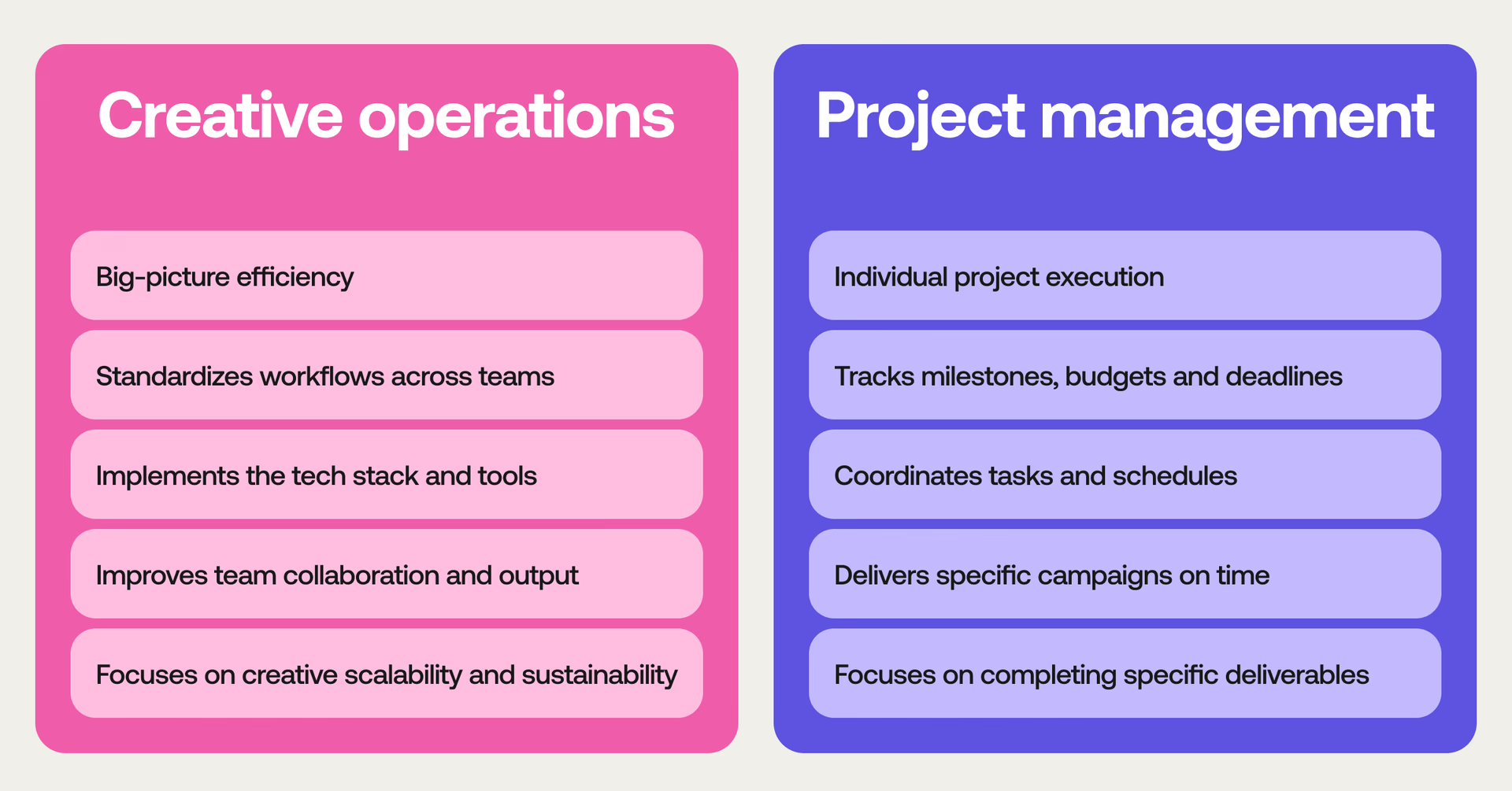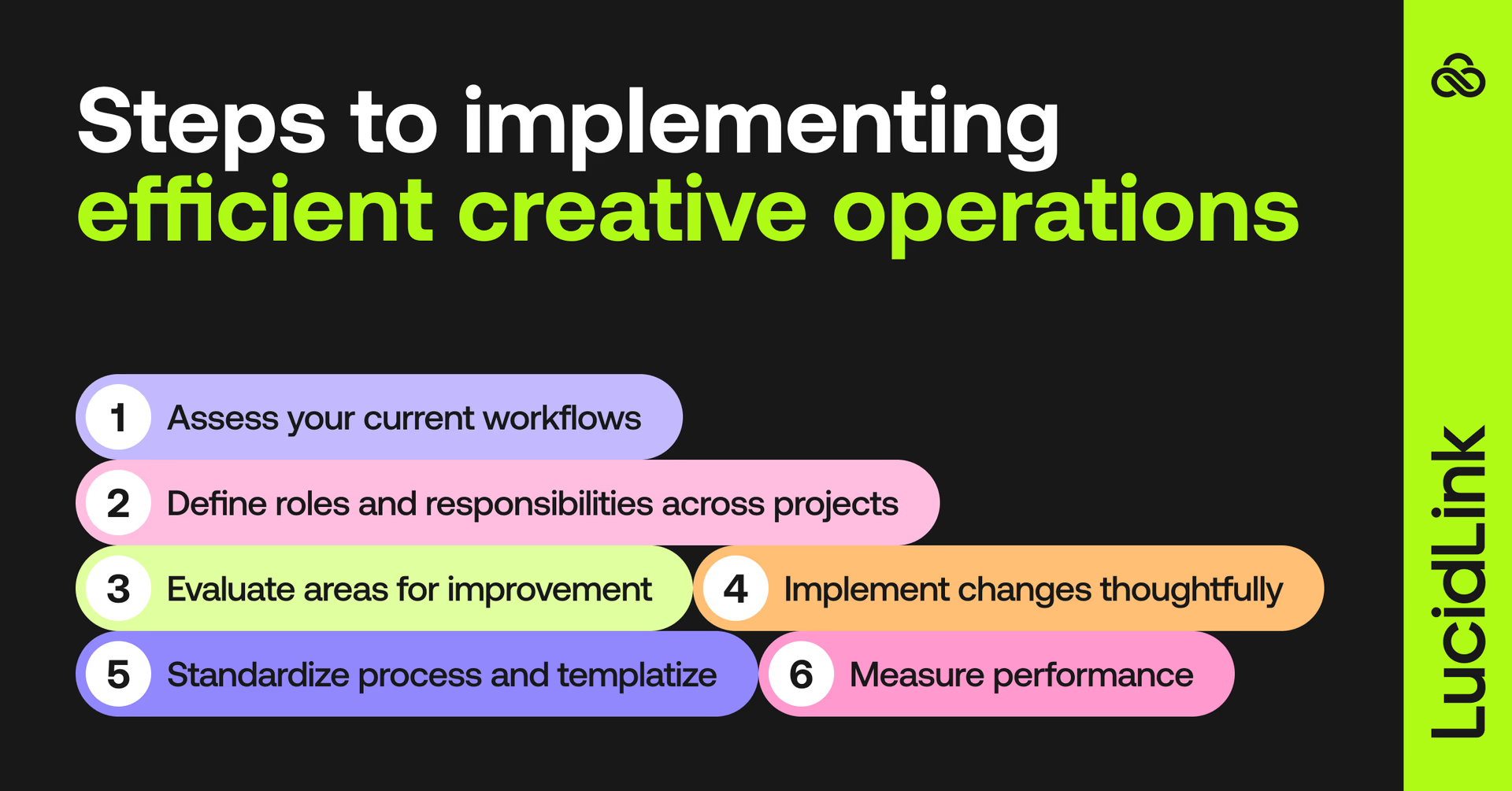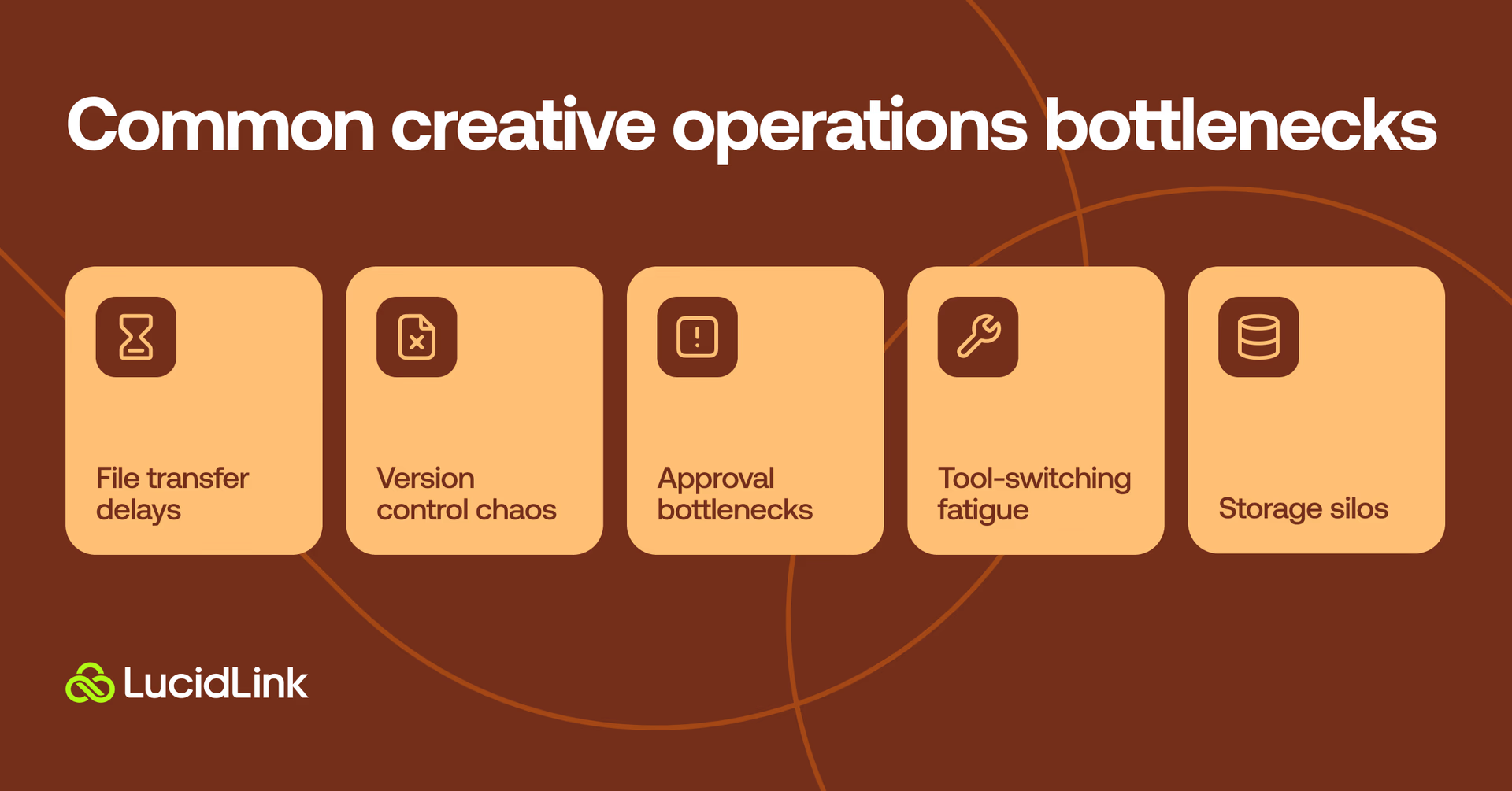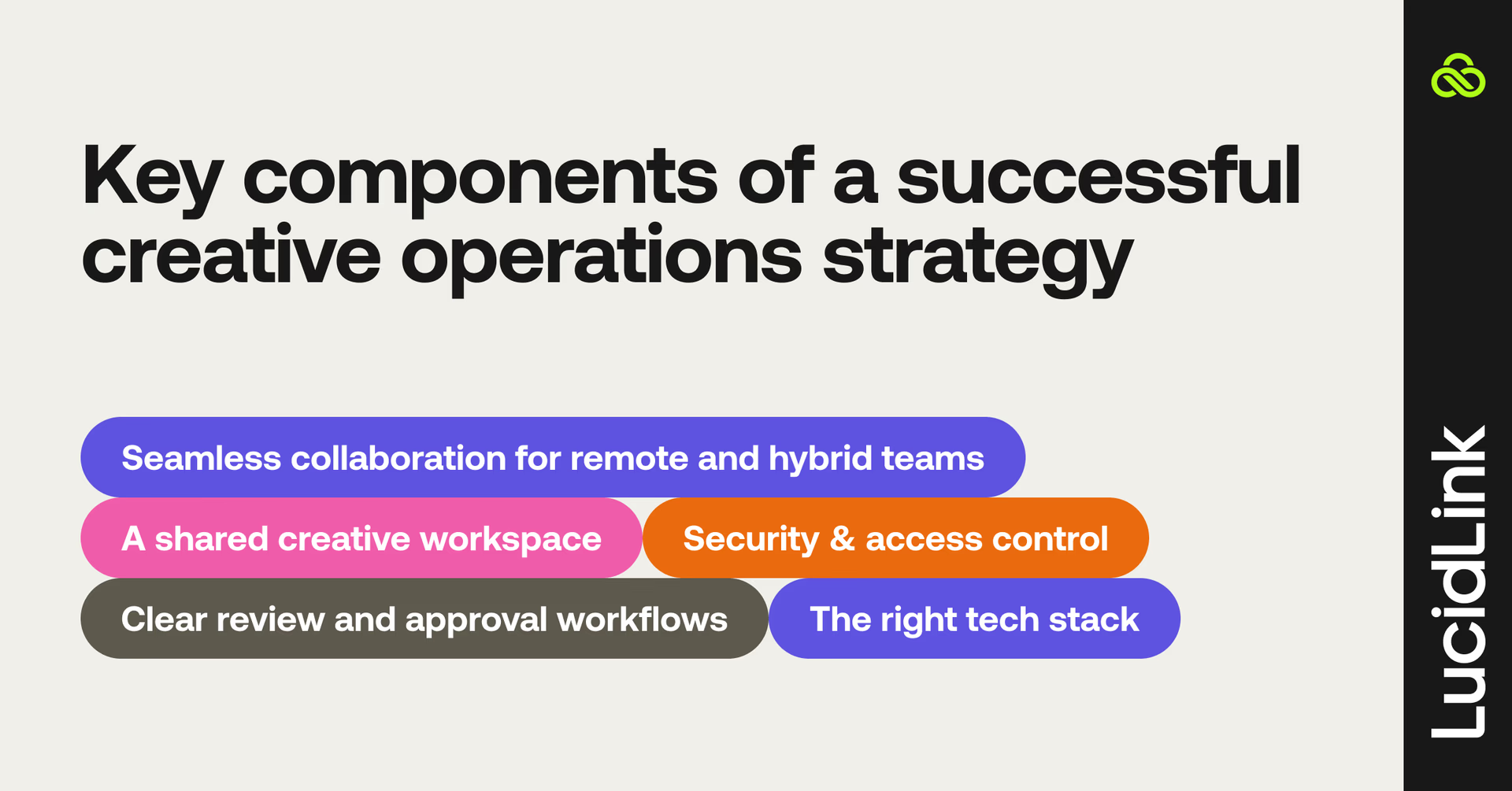Creative production
Collaboration
Creative operations: how to streamline creative workflows
May 2025
8 mins

Table of contents
- What is creative operations (and why does it matter)?
- What’s the difference between creative operations and project management?
- 6 steps to implementing efficient creative operations
- Common creative operations bottlenecks
- 5 key components of a successful creative operations strategy
- How LucidLink simplifies creative operations
- Beyond tech: the human side of creative operations
- The future of creative operations
- Take control of your creative operations
Your files, faster.
Access any file instantly, anywhere. Collaborate in real-time from one always-up-to-date, secure cloud filespace.
Creative teams thrive when ideas flow freely, feedback is instant and assets are always accessible. But too often, the reality is the opposite.
You’re searching for files, dealing with approval delays, switching between tools and waiting on downloads.
Creative operations is the invisible glue that lets creatives do what they do best: create. It provides the structure, tools and creative workflows that let teams create without disruption.
What is creative operations (and why does it matter)?
Creative operations is the practice of streamlining the workflows, processes and resources involved in producing creative content.
It’s just as essential for in-house creative teams juggling internal requests as it is for agencies managing multiple clients and projects through a well-oiled creative agency workflow.
If you work in a creative team, you probably already know what a lack of creative operations looks like. Teams get overwhelmed, deadlines slip and creative energy gets wasted on tool-switching and file-finding instead of producing great work.
On the flip side, good creative operations management ensures your team has the right workflows, templates and tools in place to focus on being creative.
What’s the difference between creative operations and project management?
Project management and creative ops are closely related — and often confused.
Creative ops is a broader system of thinking that addresses many of the same issues as project management. Think of project management as just one discipline held under the creative ops umbrella.

On a small team, one person might wear both hats — planning campaign timelines while also defining how content is approved. But on larger teams, creative ops is a distinct function focused on making all creative work more efficient, not just one project at a time.
Without creative ops, project management just focuses on putting one foot in front of the other. And without project management, creative ops would be too focused on tools and efficiencies to get individual projects out of the door.
In order to succeed you need both, and it pays dividends to keep the forest (creative ops) and the trees (project management) in mind simultaneously.
6 steps to implementing efficient creative operations
Creative ops makes a little more sense if you think through how it may impact your team. How might the process below unearth some new efficiencies for you?

1. Assess your current workflows
Start by making an audit of all recurring projects or project types, looking for pain points and time sinks.
2. Define roles and responsibilities across projects
List everyone involved in each project (this can include clients and people outside of the department) and their responsibilities. Spot redundant layers of approval or steps to streamline workflows.
3. Evaluate areas for improvement
The audit in the above two steps should unearth some opportunities. In particular, zero in on approvals, creative asset management, communication standards and project intake. These are usually ripe for creative ops optimization.
4. Implement changes thoughtfully
Whatever changes you’re making — whether it’s a process tweak or a new tool — put some thought into when and how it can be implemented, and how you can support the team in the process.
5. Standardize process and templatize
Go back to your workflows and build in any new processes, tools or communication guidelines that your evaluation uncovered.
6. Measure performance
Track metrics over time to see how the new ops impact the team. You may want to measure budget, hours or even a simple net-promoter score. Remember, good creative operations should make creatives happy!
Common creative operations bottlenecks
Creative teams thrive on collaboration: a free flow of ideas that inspires ego-free teamwork and come-from-anywhere creativity. But good creative collaboration — like any worthwhile relationship — requires work, upkeep and communication.
Creative ops is a systematic way to maintain that good collaboration. Let’s run through a couple of the bottlenecks that may be stifling your team’s mojo.

Creative operations killer 1: file transfer delays
Teams working with visual assets like video and RAW photo imagery often have to share huge files.
This can lead to:
Hours lost waiting for uploads/downloads
Slow handoff on tasks for remote teams
Workarounds like shipping drives that kill speed and budget
Creative operations killer 2: version control chaos
When you’ve got multiple people working on a complex creative asset, you need the latest version of the file — not a folder full of five “final_final_v6_thisoneREAL.mp4” variants.
But without a creative ops system in place, chaos ensues:
Time wasted redoing outdated work
Confusion around which version is approved
Hunting through email chains and shared drives to find the right asset
Creative operations killer 3: approval bottlenecks
Getting the right eyes on the work at the right time is key to creative success. But approval workflows can be incredibly complicated, with individual team leads and client touchpoints spiraling out of control.
Creative ops can help handle:
Long waits for sign-offs
Feedback scattered across email, Slack and PDFs
Revisions delayed because the wrong version was reviewed
Creative operations killer 4: tool-switching fatigue
Creatives have preferred tools: Google docs, PhotoShop, Ableton, Final Cut Pro and so on. But spread across a large workflow this can lead to:
Losing creative momentum dealing with different logins and loading screens
Fragmented workflows causing inefficiencies
Increased subscription costs and administrative workload
Creative operations killer 5: storage silos
Creatives work best when they have what they need, when they need it. But a lack of creative ops can lead to a labyrinth of different folders and storage systems.
Creative ops helps save:
Files trapped across hard drives, servers and cloud storage
Wasted time hunting for assets
Want to eliminate these bottlenecks for good? LucidLink helps creative teams cut delays, streamline approvals and centralize assets — all without switching tools or uploading a single file.
Savings calculator
Every second counts
See exactly how much time and money your team could save with LucidLink.

5 key components of a successful creative operations strategy
So, you’re sold on the importance of creative ops for your team. But what does a good end state look like?

Creative ops nirvana should include:
A shared creative workspace: your team needs a single source of truth for all assets. They should pull from and save to the same space.
Clear review and approval workflows: approvals are key to good creative work but they can eat up your time (and they’re worth nothing if feedback gets lost). Make sure this area of your ops is clearly defined and relevant to your team’s needs.
Seamless collaboration for remote and hybrid teams: scaling for hybrid or fully remote workspaces is a must these days, so make sure you’re utilizing cloud collaboration tools smartly.
The right tech stack: when evaluating tools, look for efficiencies — see if your project management software will send updates to Slack channels, for example. And resist the desire to lean too heavily on tools — people can only remember so many log-ins.
Security & access control: clients want to know their work is being kept safe. And management wants to know that the right people have access to the right files. Good creative ops should facilitate this.
If you’re successfully hitting all of these notes with your creative ops, your team’s in a good place. If you’re not, don’t fret — along with the strategies we’ve discussed, there’s more tech that can help.
How LucidLink simplifies creative operations
LucidLink isn’t just another storage tool — it changes the way you work and eliminates creative workflow bottlenecks.

We give creative teams instant access to their files — from anywhere, at any time, in any tool. No downloads, no duplicates, no delays, just one centralized, secure filespace for everything you’re working on. That means:
Instant file access
One source of truth
Seamless collaboration from anywhere
Faster approvals
Enterprise-grade security
It’s a creative ops supercharger. Read more about our platform and how it works here.
Beyond tech: the human side of creative operations
Tools matter. But how you support your team matters more. There’s a human side of creative ops that also needs to be tended to.
Along with finding the right workflows and tools, invest some mental resources in “softer” creative operations work, such as:
Training teams to adopt better workflows: not everyone learns at the same pace or in the same way, so give folks room to onboard over time.
Balancing structure with creative flow: creatives need to be in the right headspace to create. That might mean fewer meetings, more flexible hours or time to transition between tasks.
Change management: even if you know a new tool is perfect for your team, people are naturally resistant to change. Nurture the early adopters of a new tool and don’t be afraid to work directly with people who resist it.
This isn’t a one-and-done task. Keep checking in. Ask what’s working and what’s not — and be ready to adjust. A team that feels supported will always produce better work.
The future of creative operations
Because creative operations is a wide-ranging discipline — touching on tools, time-tracking, planning, budgeting and nitty-gritty creative work — tech advancements can have an outsized impact.
In the months to come, keep your eyes open for new evolutions in the field, including:
AI-powered automation: look for intelligent integration of AI into your workflow. New tools already speed up or eliminate onerous manual work, like tagging imagery fresh from a shoot or predicting which assets you need at a given time.
More cloud-based collaboration: the more work you have saved in the cloud, the quicker and easier it is for team members (in office, remote or hybrid) to access and work on them.
Better integration of creative ops throughout the org: look for forward-thinking teams and agencies to have dedicated creative ops managers or even whole departments focused on keeping creative people at their best.
Take control of your creative operations
Creative ops takes everything your team uses in the process of making creative content and streamlines it. It seeks out pain points and time-sucks and eradicates them methodically.
Whether you’re producing social content or launching global campaigns, a strong creative ops strategy gives you the foundation to move faster — and with less stress.
If you’re ready to cut the chaos and keep creative work flowing, try LucidLink free for 30 days.
Keep reading

Creative production
How to build a creative workflow that really flows
Discover how to build a seamless creative workflow using practical strategies and tools. Get tips for collaboration and creative project management.
26 November 2025, 17 mins read

Product & news
Collaboration
Cloud storage
Why sync when you can stream? File streaming vs sync and share
Explore how sync and share tools disrupt large file workflows and how LucidLink’s file streaming platform delivers instant, secure file access from anywhere.
24 November 2025, 6 mins read

Collaboration
In the field
Madecraft’s post-production hacks for smooth workflows
Discover how Madecraft slashes hidden costs of post-production, boosting efficiency, saving time and keeping creativity flowing.
21 November 2025, 6 mins read
Join our newsletter
Get all our latest news and creative tips
Want the details? Read our Privacy Policy. Not loving our emails?
Unsubscribe anytime or drop us a note at support@lucidlink.com.